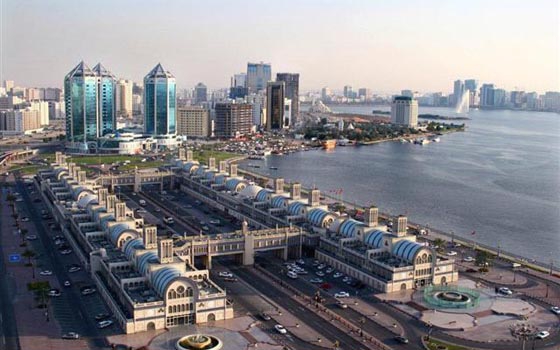While falling property prices in Dubai have reduced Sharjah’s real estate competitiveness over the last year, a spate of large-scale, mixed-use developments and improvements to transport infrastructure are spurring a more positive market outlook.
As its closest neighbor, Sharjah has historically benefitted from growth in the Dubai property market, presenting itself as an affordable alternative for those living and working in the region.
Starting last year, however, Sharjah experienced the flipside of this, as falling prices in Dubai caused demand to weaken and rental prices to ease. Rents in Sharjah declined by an annualized 8.3% in the first quarter of 2016, according to the latest report from property consultancy Cluttons.
Given the weaker short-term outlook for Dubai, Cluttons predicts rents in Sharjah will ease by a combined 3-5% this year, though a turnaround is expected in mid-2017, when jobs linked to Dubai’s Expo 2020 will begin to have an impact on demand.
Emirate remains competitive on price
Sharjah continues to be attractive though, with rental rates for mid-market properties typically half the cost of those in Dubai.
In the third quarter of last year, for example, studio rental prices averaged Dh26,000 ($7080) per annum in Sharjah, compared to Dh52,000 ($14,160) in Dubai, according to real estate services company Asteco.
In addition, rental prices in Sharjah are historically less volatile thanks to government regulations that lock in rates for three years at a time.
“Sharjah is not a freehold market like Dubai, and therefore does not see as sharp of swings in prices,” Saeed Al Suwaidi, managing director of Al Ghanem Real Estate, told OBG. “This also protects the market from property flippers and unnecessary speculation, attracting renters that are more likely to feel a long-term commitment to the market.”
Even against the more subdued market backdrop, Cluttons noted that demand for high-end suburban-style properties and gated communities remains strong in Sharjah.
“Demand for suburban-style living continues to rise in the emirate, predominantly because of the relative affordability when compared to Dubai,” the report said.
The long-term hope – and one that is being backed by developers – is that Sharjah begins to complement its affordability with a competitive lifestyle offering. The recent completion of an Dh11.4m ($3.1m) city-center roadwork project, as well as a series of large-scale developments in the pipeline, is encouraging investors to examine Sharjah’s potential as an alternative to Dubai.
New developments draw international attention
Sharjah is already the third-most-attractive property investment destination in the GCC, according to a recent survey by Cluttons. Of the high-net-worth investors surveyed, 8% identified Sharjah as one of their top-three destinations, behind Abu Dhabi (21%) and Dubai (27%).
Continued investment in real estate bodes well for Sharjah’s long-term economic prospects. The sector forms a vital part of the emirate’s economy, with real estate and business services accounting for a combined 21% of economic activity.
Tilal City, Sharjah Waterfront City and Al Zahia are among the highest profile of a swathe of major residential developments seeking to capitalize on market demand for affordable luxury.
The Dh2.4bn ($653.3m) Tilal City development spans 25m sq ft and comprises 1855 land plots. According to developer Tilal Properties, the project has attracted investors from more than 25 countries to date.
“Tilal City is unique in that it is being developed as a public-private partnership, which have not typically been utilized in the real estate sector in Sharjah,” Khalifa Shaibani, director-general of Tilal Properties, told OBG. “If the project is ultimately successful, I see opportunities for many similarly structured projects in the future.”
Such a geographically diverse investor profile has been made possible by recent changes to the emirate’s property investment regulations. While freehold ownership remains restricted to citizens of GCC countries, a law passed in late 2014 allows investors of any nationality to purchase leaseholds for terms of 100 years in designated developments outside the city centre.
Another major project open to foreign investors is Sharjah Waterfront City, which is being developed by Sharjah Oasis Real Estate Development.
Listed as the third-largest mixed-use development in the GCC, the project will accommodate 200,000 people upon the completion of 10 islands, which are to be connected by bridges and canals along 36 km of coastal land on the north-east side of the emirate. According to local media reports, the project is being built at a cost of between Dh18.5m ($5m) and Dh20m ($5.4m).
Lastly, Al Zahia, a joint venture between Majid Al Futtaim and the Sharjah government, is being developed as the emirate’s first gated community. Spanning more than 1m sq meters, the community is expected to have capacity for 12,000 residents when it opens in 2018.
Located near Sharjah University City and Sharjah International Airport, and near strategic road links to Dubai, the development offers a range of three-, four- and five-bedroom townhouses, villas and apartments, with the first 51 homeowners taking possession of their homes last year.
Further investment could be directed to the area following the announcement that Majid Al Futtaim is planning to build a super-regional shopping mall within the community. The new mall, City Centre Al Zahia, will have a gross leasable area (GLA) of 130,000 sq meters.
Meanwhile, construction on Tilal Mall, which is expected to have 94,121 sq meters of GLA and will be located at Tilal City, is set to begin next year with opening scheduled for 2019, according to press reports.
Oxford Business Group
4 October






















































